The one that got away – Malaka Pathmalal
In 2006, leaving for Anuradhapura on a family trip, Malaka Pathmalal decided on a whim to grab his simple ‘point-and-shoot’ Minolta. He got some pictures, found he’d enjoyed himself, and after that he always had a camera with him, even in school. “I don’t know where the desire to document came from; but I think I’ve always had it.”
He still works with film, by preference, but by 2011 his ‘Colombosensei’ alter ego (a nod to his training as a primary teacher and love of all things Japanese) was partnering with Instagram, hosting annual meet-ups, street-photography walks, and seminars at the now-defunct Castle Hotel. In recent years, he has augmented that original passion with an enthusiastic line in coffee and/or food photography.
Between times, he’s contributed to the Canadian press on Jaffna cottage-industries, been hit in the face by a rubber bullet on Ward Place, done the occasional corporate gig, and been asked to photograph a (presumed) suicide from Galle ramparts… because the police there didn’t have a camera. His literally greatest hit to date has been a 14x7ft flexiboard panorama of Colombo’s skyline, shown at Colomboscope.
The one that got away
‘In 2016 I was doing a Roar feature on the nattamis of Pettah. I’ve been documenting Pettah for years – one day that whole way of life is gonna get hit for six – and I know it like the back of my hand.
I walked into this lane off Prince Street, and I found – like anywhere down there – this large open shopfront, and a tailor, sewing something. It was obviously a lovely picture: good leading lines, a natural black frame, a beige wall, and this man right in the middle, with a nice big beard and a cap, with all this colourful fabric around him. So I lifted my camera, took the picture, and then looked down at it and decided that one wasn’t great. So I deleted it.
But then the guy looks up, and says “What did you just do?? Who the hell are you?!” I started to say that I was working for a media company, doing a story; but then he gets up and storms over, and demands to know why I’ve been taking pictures of him – at which point I knew that there was something very wrong. And then he started swearing at me. Complete filth!
Now, legally, if you are in a public area, you can take whatever pictures you like. But it turned out that, a couple of weeks before, someone else had taken a picture of him – in the exact same situation – and then written a smut article in the papers, saying that he was selling cocaine, that he’s a pimp, things like that. And he and his family had been humiliated.
So next thing you know I have a dozen people around me, pinning me against the wall. I showed them on my camera that I did not have anybody’s picture; but by that time it seemed like they just wanted a scapegoat to vent their frustrations on. I was very close to getting badly beaten up. Ultimately I had to talk them down for about 45 minutes. But even then they warned me never to come that way again. And I still don’t.’
The shot that he got
‘This one is from a story that I never published, on the Wanathamulla project, part of the urban rejuvenation plan a couple of governments back: new, free accommodation, to make Colombo a better, greener place.
They were clearing slums along the railroad in Narahenpita. We call this a ‘slum’, but families lived there their whole lives, in reasonably large houses. From about 2012-2015 I used to commute along that line, between my teaching jobs, and there were kids who’d run up and down along the tracks, and sometimes I’d sit and take tea with them in the evening.
So I documented it: domestic interiors, laundry, people playing cricket, a baby sleeping on the floor, schoolchildren helping their parents pack up their homes (that broke my heart). And then their houses being torn down. There was also this statue of St Anthony, I think, right next to the railroad: the patron saint of the poor, and of lost things. They sometimes had festivals for it.
What the government didn’t say is that every person who’s moving house is being forcibly removed, and that they have to pay for being moved. But that information was starting to leak at this time. So while I was photographing, some guys appeared and started asking me all sorts of very detailed media-related questions. And then suddenly there were cops outside my house all week. It might have been coincidence.
Anyway, I passed this place every day for a couple of years, so to see it now like this was very sad.
And these are pictures that I wish Colombo would have seen. The government promised that nothing would happen to the statue. But as far as I know it has also disappeared.’

‘In search of lost things’- by Malaka Pathmalal


